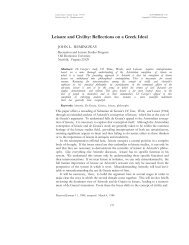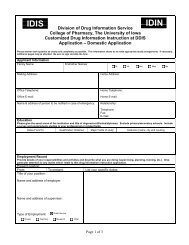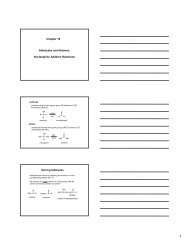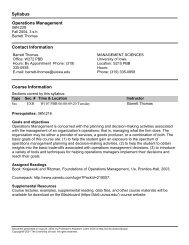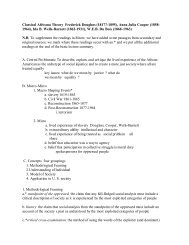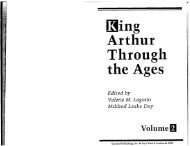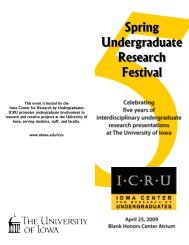Twenty-Five Years of Batson: An Introduction to ... - University of Iowa
Twenty-Five Years of Batson: An Introduction to ... - University of Iowa
Twenty-Five Years of Batson: An Introduction to ... - University of Iowa
You also want an ePaper? Increase the reach of your titles
YUMPU automatically turns print PDFs into web optimized ePapers that Google loves.
2012] TWENTY-FIVE YEARS OF BATSON 1415<br />
“require at step one” 188 a showing “that it is more likely than not” that the<br />
contested peremp<strong>to</strong>ry challenges were discrimina<strong>to</strong>ry. 189 <strong>An</strong> eight-Justice<br />
majority concluded that the “‘more likely than not’ standard [was] at odds<br />
with the prima facie inquiry.” 190 According <strong>to</strong> the Court, a more likely than<br />
not standard at the prima-facie-case stage was inconsistent with <strong>Batson</strong>’s<br />
language, which did not demand that an objecting party “persuade the<br />
judge” but merely required “evidence sufficient <strong>to</strong> permit the trial judge <strong>to</strong><br />
draw an inference that discrimination ha[d] occurred.” 191 Once an<br />
inference arose, <strong>Batson</strong>’s “burden-shifting framework” prescribed two<br />
additional steps that afforded “the trial judge . . . the benefit <strong>of</strong> all relevant<br />
circumstances . . . before deciding whether it was more likely than not that<br />
the challenge was improperly motivated.” 192 <strong>Batson</strong> observed that a party is<br />
entitled <strong>to</strong> relief if she establishes a prima facie case and the opponent does<br />
not <strong>of</strong>fer a neutral explanation. 193 This did not mean that an objecting party<br />
had <strong>to</strong> satisfy the ultimate burden <strong>of</strong> persuasion on purposeful<br />
discrimination at step one. 194 While that burden always rests on the<br />
objecting party and never shifts <strong>to</strong> the party that exercised the peremp<strong>to</strong>ry<br />
challenges, the function <strong>of</strong> “[t]he first two <strong>Batson</strong> steps [is <strong>to</strong>] govern the<br />
production <strong>of</strong> evidence that allows the trial court <strong>to</strong> determine the<br />
persuasiveness <strong>of</strong> the . . . constitutional claim” in step three. 195<br />
The majority found additional support for this interpretation in<br />
“<strong>Batson</strong>’s purposes,” which include “the overriding interest in eradicating<br />
discrimination from our civic institutions.” 196 <strong>Batson</strong>’s doctrinal scheme was<br />
“designed <strong>to</strong> produce actual answers” when there is reason <strong>to</strong> suspect<br />
discrimination and <strong>to</strong> avoid “speculation” when a court can obtain “direct<br />
answer[s].” 197 The “three-step process” prescribed—including the demand<br />
for a mere “inference <strong>of</strong> discrimination” in step one—vindicates <strong>Batson</strong>’s<br />
188. Id. at 168.<br />
189. Id. (quoting People v. Johnson, 1 Cal. Rptr. 3d 1, 13 (2003), rev’d, 545 U.S. 162)<br />
(internal quotation marks omitted). California had held that <strong>to</strong> establish a prima facie case <strong>of</strong><br />
discrimination, the party raising a <strong>Batson</strong> objection must show that it is “more likely than not” that<br />
the striking party had “discrimina<strong>to</strong>ry intent” and had concluded that the trial court had not<br />
erred in finding that the defendant had not met that standard. Id. at 167 (quoting Johnson, 1<br />
Cal. Rptr. 3d at 10) (internal quotation marks omitted).<br />
190. Id. at 173.<br />
191. Id. at 170.<br />
192. Id.<br />
193. See id.<br />
194. Id.<br />
195. Id. at 171. In the “unlikely” case that a party declines <strong>to</strong> pr<strong>of</strong>fer any reason, this<br />
“refusal <strong>to</strong> justify [a] strike in light <strong>of</strong> [a] court’s request . . . would provide additional support<br />
for the inference <strong>of</strong> discrimination raised by [the] . . . prima facie case.” Id. at 171 n.6.<br />
196. Id. at 171–72.<br />
197. Id. at 172.





